Living Cities: creating flower rich urban meadows
The Trust’s Living Cities publication outlines practical actions that can be taken to embed nature into the urban environment.
In this guest blog, Leonie Alexander from the Royal Botanic Garden Edinburgh explains how to transform amenity grass into to vibrant flower rich meadows, and how this can benefit wildlife.
Imagine the scene – the sound of birdsong, grasshoppers leaping out from under your feet, an array of colour, bumblebees feeding on red clover, hoverflies on oxeye daisies, a red admiral basks in the sun.
Wildflower meadows are full of life and there is an enormous push to create more in agricultural landscapes to redress a 98% loss of lowland meadows across the UK as a result of farmland improvement, and in urban areas where they enhance areas of pretty functionless amenity grassland.
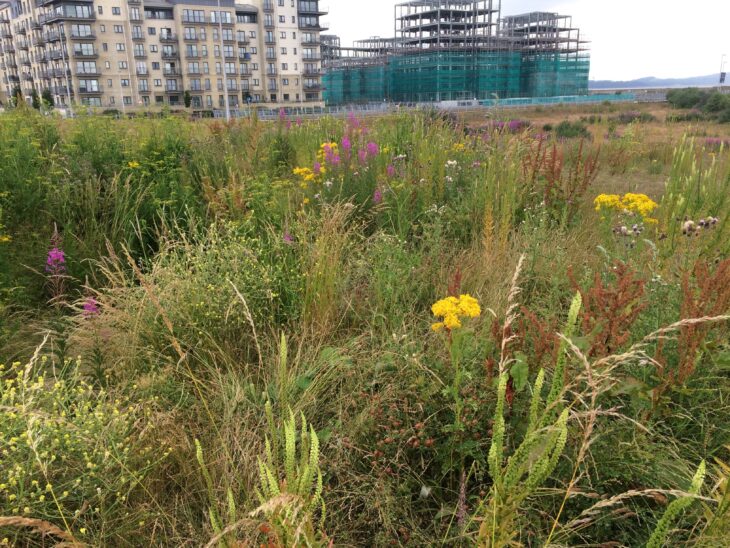
There are a whole range of types of meadows depending on ground conditions and management. In urban areas the aim is generally to create something similar to a grazed hay meadow – something that was ubiquitous on British farms until post-war improvement.
The presence of livestock has significant impacts on the system which are difficult to replicate, but this is what we are aiming to do when creating flower rich grassland in the city.
Other flower rich grasslands include: wet meadows with more specialist plants and maintained by seasonal flooding; dry, free draining coastal grassland often maintained by rabbit grazing; acid grassland in the hills; and calcareous grassland, which can host an amazing diversity of specialist plants occurring only on alkaline rock.
How to create a flower rich grassland
The focus of this blog is to provide a brief checklist for how to create a flower rich grassland in an urban area currently dominated by amenity grassland – typically made up of a limited number of hard wearing grass species and very few flowers which can tolerate trampling, such as daisies.
Assuming you have found a suitable site this is what you need to consider:
- Existing conditions: What is already growing there? Check for any evidence of flowering plants within the grassland. If there is an array of different species already it may be possible to just relax the mowing regime and see what comes up. If there is just bright green grass (see the image below) you will have to do some more serious intervention.
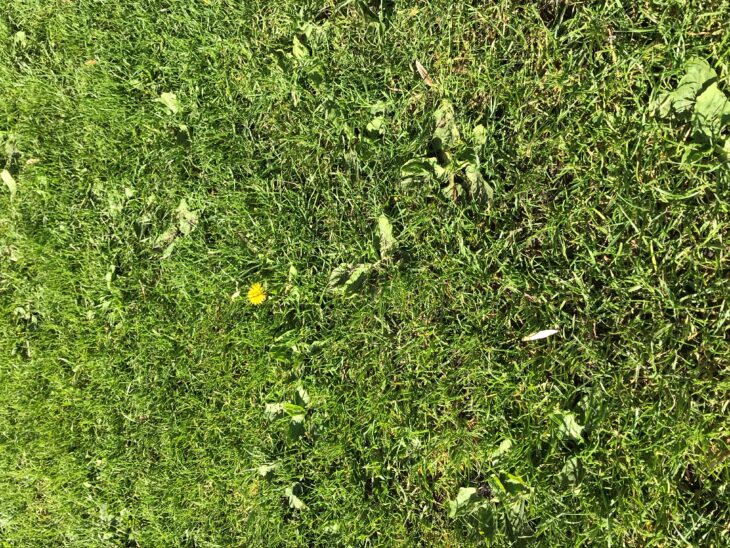
- Soil fertility: Amenity grassland is often treated with fertiliser and as nature is pretty thrifty with nutrients these tend to stay within the system. If you have a very fertile site then a few competitive grass species will dominate at the expense of all the rich flower diversity. Fertility can be reduced by removing the turf and top soil to a depth of around 10 cm, depending on conditions.
- Create a top quality seed bed: Rotovate or cultivate the soil and if you have time let weed seeds germinate and knock them back again before you seed with a suitable native seed mix. You might like to try the Urban Pollinator Mix devised jointly with University of Edinburgh researchers and available from Scotia Seed. This mix features early to late flowering species to offer something for wildlife throughout the season.
- Seed selection: Choose your seed carefully. Scotia Seeds is an excellent source of local origin and provenance Scottish seed. This is recommended over seeds which may contain some of the same species but not the local genetic varieties typical to Scotland. Sow according to instructions. It can be useful to mix the seed mix with fine silver sand, so you can distribute evenly, and you can see where you have been! Once seeds are sown trample or roll them in so there is good contact between seed and soil.
- Timing: It’s best to sow wildflowers in spring or autumn to mimic the natural system of seed germination. Be patient. some seeds can take several years to germinate so your grassland will change species composition over the years.
- Regular management: Try to achieve a regular routine of management so that local species adapt to this rhythm of cutting and raking. Management can be one or two cuts a year – so in spring do an early cut and in late summer/autumn cut and rake off. Removing the cut material is the key to success to prevent flowering plants becoming swamped and to reduce fertility. For small areas this can be a community event and cutting can be done with scythes if you are up for a bit of physical activity!
- Plug plants: If you don’t have the resources to completely rework an area of amenity grassland you could try introducing plug plants. Portobello residents have recently been doing this at Seafield and are monitoring the results.
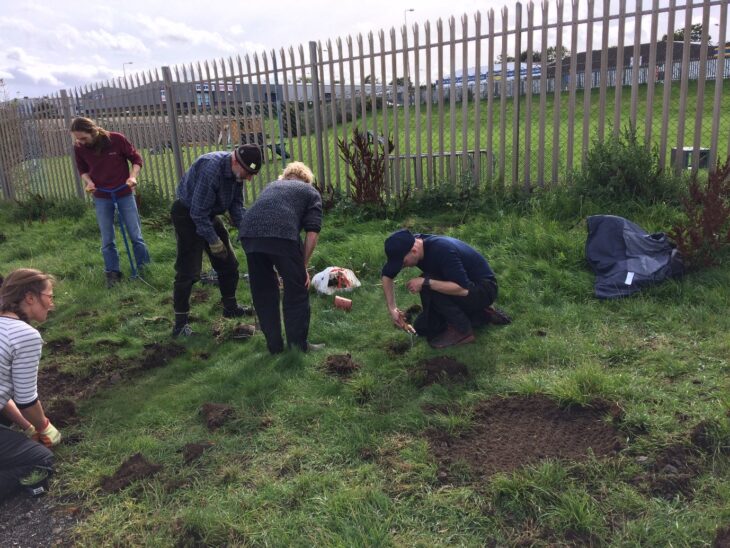
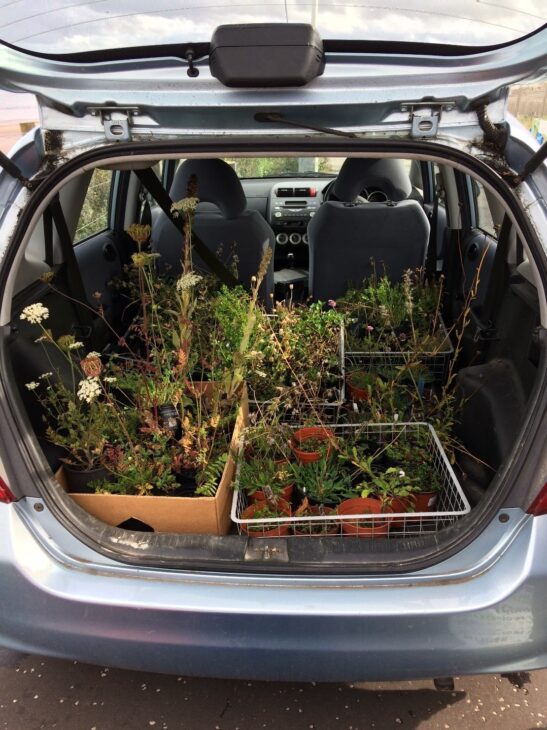
At a number of trial plots at Cramond foreshore invasive Japanese rose is being removed and three different treatments have been introduced to establish coastal grassland – seeding with coastal plants, planting out coastal plug plants from the Granton Hub nursery and a no treatment control.
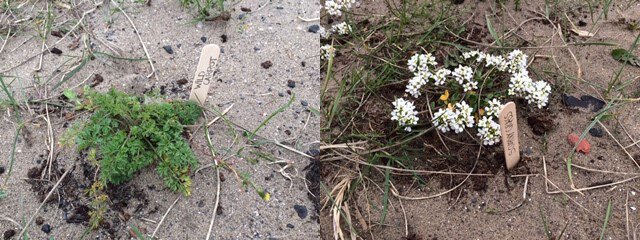
Consider the bigger picture
Another thing which is well worth considering is the wider context of your site. Wildflower areas are more valuable if they are located within an area of mixed habitats. Some species can use patchy habitats– for example pollinators which fly from one flower rich area to the next – but less mobile species are not able to do this, so connections to other areas of suitable habitat are important.
Ideally areas of flower rich meadow would grade into unmanaged grassland and then into mixed scrubby grassland and woodland. Of course, this is not always possible and it certainly doesn’t mean that creating small flowery areas is not well worth the effort.
If you want to create a meadow but can’t find a suitable site you can always plant up window boxes or other containers and make a mini meadow. After all your efforts make sure you take the time to watch new residents moving in or passing through.
Finally, if you are buying plants or bulbs always chose organic suppliers or ask if any pesticides have been used in production. If they have, don’t buy them. There’s no point in doing something positive for wildlife if chemical residues can damage them!
There are a couple of films on the creation and management of urban meadows and biodiversity available from RBGE which you might find useful, you can find these on our website.
Leonie Alexander is Urban Biodiversity Project Officer for the Royal Botanic Garden Edinburgh. She can be contacted by email at l.alexander@rbge.ac.uk.
Help protect Scotland’s wildlife
Our work to save Scotland’s wildlife is made possible thanks to the generosity of our members and supporters.
Join today from just £3 a month to help protect the species you love.
Preface
The Trust’s Living Cities publication outlines practical actions that can be taken to embed nature into the urban environment. In this guest blog, Leonie Alexander from the Royal Botanic Garden …
